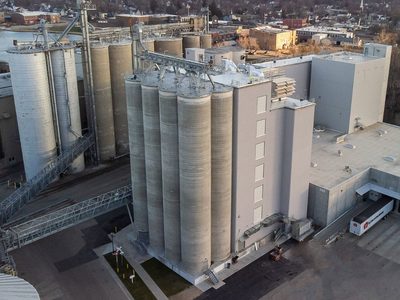As financial markets in September took note of the one-year anniversary of the start of their near brush with total collapse, the soybean market faced an anniversary of its own: the beginning, two years ago, of a huge price rally to record highs. And, as many economists think the dramatic bearish moves in financial markets most likely have ended, many agricultural analysts think the historic bullish chapter in soybean markets may have come to a close.
In late September, soybean prices, as measured by cash prices to U.S. farmers, fell below $325 a tonne for the first time since October 2007, representing a 35% drop from the record high of nearly $500 set in July 2008. The fall has not occurred in a straight line; prices plummeted to $330 in December, rallied from March through June 2009, and then eased a bit before plunging in September.
The proximate reason for the decline to two-year lows was the increasing prospect of record harvests. Without an early frost in the Northern Hemisphere — a fear that eased with every passing frostless week — the U.S. Department of Agriculture (USDA) in September predicted 2009-10 U.S. soybean production at 88.3 million tonnes, 3% higher than the previous record high of 87 million in 2006-07.
Southern Hemisphere producers, who were in early planting stages in late September, also are forecast to bring in bin-busting harvests. The easing of Argentina’s drought should result in 2009-10 output of a record 51 million tonnes, the USDA said, while Brazil’s production is projected at a record high 62 million.
On a global level, 2009-10 soybean output should reach about 244 million tonnes, 7 million higher than the previous record of 237 million in 2006-07 and 30 million more than in 2008-09. The increased supplies, coupled with only a 10-million-tonne increase in aggregate domestic consumption, will allow global ending stocks to expand for the first time in three seasons.
For the U.S., that expansion is critical. The USDA estimated 2008-09 ending stocks at only 3 million tonnes, the lowest since 2.8 million in 1976-77 and a record low 6.2% of use. That tightness has been a factor in the market’s volatility, spurred by on-again, off-again fears of new-crop frost damage.
The September USDA projections doubled 2009-10 U.S. ending stocks to 6 million tonnes, which would represent a more comfortable 11.8% of use and would mark the first time in three years that production has outpaced use. With the release of that number, prices sank as the crop continued to dodge a damaging frost event.
The price drag of larger soybean supplies has more than offset prospects for continued strong demand. Globally, domestic consumption is forecast at a record 231.6 million tonnes, while projected exports, at 77 million tonnes, would be the second largest behind 79.5 million in 2007-08.
The U.S. is forecast to export 34.8 million tonnes in 2009-10, equal to its record 2008-09 high, and Argentina, with its increased availabilities, should see 2009-10 exports of 9.7 million versus 5.9 million a year earlier. Based on Argentina’s improved position, Brazil’s exports should slip to 24.5 million tonnes against its record 29.35 million in 2008-09.
The demand driver continues to be China, which imported its record 39.8 million tonnes in 2008-09, representing 54% of total world imports. With its economic growth thought to remain robust despite the global slowdown, China’s soybean crush should expand to another record in 2009-10.
China’s 2009-10 imports are forecast to slip by 1.3 million tonnes, despite a projected 1-million-tonne drop in domestic production, based on China’s reserve holdings. Although Chinese purchases of U.S. soybeans through late summer were aggressive, China’s government is expected to auction off some reserves, using subsidies to draw processors away from imported supplies.





